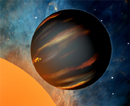 It sometimes seems like the exoplanet folks put out a press release every time anything half way novel or solar system-like is found. What we don’t hear about are the boring discoveries that fill in the details. One recent paper seems to be flying under the press engine radars. Written by a team of astronomers lead by Frederic Pont, this paper discusses how observations of the Jupiter-sized planet orbiting HD 189733 doesn’t have rings, doesn’t have an overly large moon, and generally just doesn’t have anything hugely exciting in its orbit. HD 189733 did provide a bit of excitement: its active atmosphere provided some star spots for the planet to eclipse. (image credit: CFA / David Aguilar)
It sometimes seems like the exoplanet folks put out a press release every time anything half way novel or solar system-like is found. What we don’t hear about are the boring discoveries that fill in the details. One recent paper seems to be flying under the press engine radars. Written by a team of astronomers lead by Frederic Pont, this paper discusses how observations of the Jupiter-sized planet orbiting HD 189733 doesn’t have rings, doesn’t have an overly large moon, and generally just doesn’t have anything hugely exciting in its orbit. HD 189733 did provide a bit of excitement: its active atmosphere provided some star spots for the planet to eclipse. (image credit: CFA / David Aguilar)
What is neat about this paper isn’t what they did find, but rather what they were able to rule out. Using completely straightforward observations – time series photometry (admittedly with the Hubble Space Telescope) – they were able to figure out this distant world is at a certain level rather boring. The planet orbits its star every 2.2 days and has a orbital radius of 0.0313 AU (for comparison, Mercury’s orbit is 0.27 AU in radius). Its orbit is aligned almost exactly edge on (orbital angle = 85.68+/-0.04 degrees), and as it passes in front of its star we see an almost 3% dip in the star’s light. This dip is to the eye completely symmetric and beautifully curved. This shape is characteristic of a spherical object going in front of another spherical object. Had there been a moon, there would have been an asymmetric dip as the planet goes in and then the moon (or vis a versa). Had there been rings, the shape of the lightcurve (depending on the orientation of the rings) could still have been symmetric, but it wouldn’t have been as perfectly curved. There would have been a gradual dipping as the rings (which just can’t block that much light) move in front of the star, followed by a steeper dip as the much large area planet moves in front of the star. These asymmetries couldn’t be observed using ground-based telescopes because our atmosphere causes photometric measurements to have larger errors than the size of these effects. It’s sort of like trying to measure the width of a piece of hair using a yard stick. You can try, but the hair is just too small to see easily against the ruler. Hubble is the only telescope with the accuracy to handle this.
But, while to my eye the curve is a perfect curve, analysis by the team found a pair of irregularities that are consistent with the planet going in front of a star spot. These spots on the Sun are low temperature and dark, and when the planet blocks these cool spots the color of the star’s light gets bluer. It’s like when the red stage light goes out in a theater production – suddenly everything appears very blue. Of the three different transits observed, two transits had these odd, planet-probably-blocking-sunspot lightcurve wiggles. One was high significance. The other is lower probability. The star is a K dwarf (a star cooler than the Sun) known to have a strong magnetic field and an active atmosphere. These spots are just one more neat way this star has of making it self stand out as interesting.
So, at the end of the day, this is the story of a neat active star and a mighty boring, exceedingly hot planet not that different from Jupiter.



I think there might be a zero missing to the right of the decimal in the orbital radius for HD 189733.
Has anyone ever used the wobble method of searching for planets on our humble sun? Can we deduce the existence of Jupiter and Saturn from wobbles in the sun? I think it would be an interesting control study if nothing else…
Hi Robert – You’re right. Thanks for the catch!
That Neil Guy – Because the Sun is nearby, it’s possible to observe it’s wobble due tot he orbit of it’s planets with levels of detail we can’t get for any other stars with present technology. This means that careful study allows us to detail the motion of all 8 planets if we work hard enough! We use this as a stepping off point to say, if we had a telescope with [certain size], [certain placement], and [certain instruments] we could see the Earth-like planets around other stars.
Canada’s MOST doesn’t do spectroscopy, but it can certainly do the photometry for this kind of work.